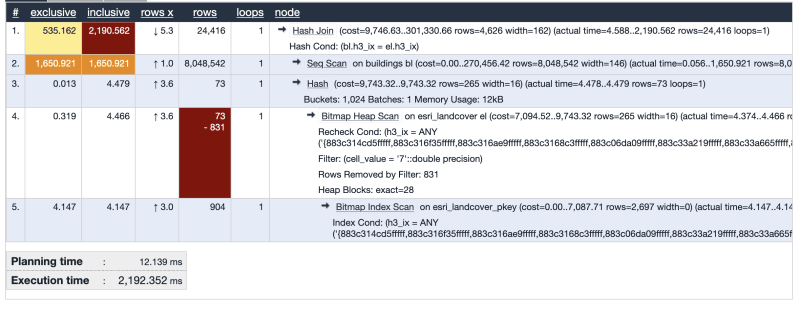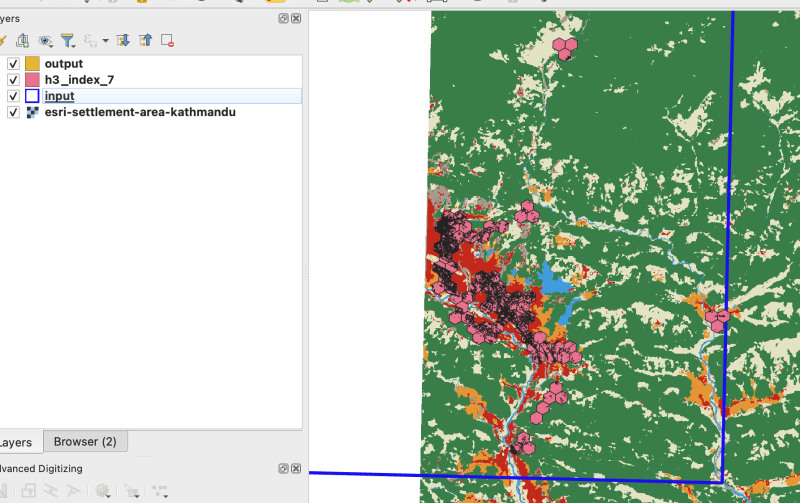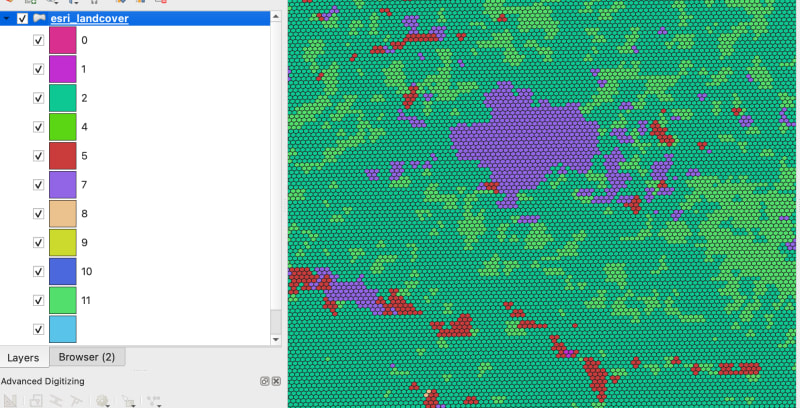Raster Analysis Using Uber hndexes and PostgreSQL
Hi , In this blog we will talk about how we can do Raster analysis with ease using h3 indexes.
Objective
For learning, We will do calculation on figuring out how many buildings are there in settlement area determined by ESRI Land Cover. Lets aim of national level data for both vector and raster .
Let's first find the data
Download Raster Data
I have downloaded the settlement area from Esri Land Cover .
- https://livingatlas.arcgis.com/landcover/
Lets download the 2023 year , of size approx 362MB

Download OSM Buildings of Nepal
Source : http://download.geofabrik.de/asia/nepal.html
wget http://download.geofabrik.de/asia/nepal-latest.osm.pbf
Preprocess the data
Lets apply some preprocessing to data before actual h3 cell calculations
We will be using gdal commandline program for this step. Install gdal in your machine
Conversion to Cloud Optimized Geotiff
If you are unaware of cog , Checkout here : https://www.cogeo.org/
- Check if gdal_translate is available
gdal_translate --version
It should print the gdal version you are using
- Reproject raster to 4326
Your raster might have different source srs , change it accordingly
gdalwarp esri-settlement-area-kathmandu-grid.tif esri-landcover-4326.tif -s_srs EPSG:32645 -t_srs EPSG:4326
- Now lets convert tif to cloud optimized geotif
gdal_translate -of COG esri-landcover-4326.tif esri-landcover-cog.tif
It took approx a minute to convert reprojected tiff to geotiff
Insert osm data to postgresql table
We are using osm2pgsql to insert osm data to our table
osm2pgsql --create nepal-latest.osm.pbf -U postgres
osm2pgsql took 274s (4m 34s) overall.
You can use geojson files also if you have any using ogr2ogr
ogr2ogr -f PostgreSQL PG:"dbname=postgres user=postgres password=postgres" buildings_polygons_geojson.geojson -nln buildings
ogro2gr has wide range of support for drivers so you are pretty flexible about what your input is . Output is Postgresql table
Calculate h3 indexes
Postgresql
Install
pip install pgxnclient cmake pgxn install h3
Create extension in your db
create extension h3; create extension h3_postgis CASCADE;
Now lets create the buildings table
CREATE TABLE buildings ( id SERIAL PRIMARY KEY, osm_id BIGINT, building VARCHAR, geometry GEOMETRY(Polygon, 4326) );
Insert data to table
INSERT INTO buildings (osm_id, building, geometry) SELECT osm_id, building, way FROM planet_osm_polygon pop WHERE building IS NOT NULL;
Log and timing :
Updated Rows 8048542
Query INSERT INTO buildings (osm_id, building, geometry)
SELECT osm_id, building, way
FROM planet_osm_polygon pop
WHERE building IS NOT NULL
Start time Mon Aug 12 08:23:30 NPT 2024
Finish time Mon Aug 12 08:24:25 NPT 2024
Now lets calculate the h3 indexes for those buildings using centroid . Here 8 is h3 resolution I am working on . Learn more about resolutions here
ALTER TABLE buildings ADD COLUMN h3_index h3index GENERATED ALWAYS AS (h3_lat_lng_to_cell(ST_Centroid(geometry), 8)) STORED;
Raster operations
Install
pip install h3 h3ronpy rasterio asyncio asyncpg aiohttp
Make sure reprojected cog is in static/
mv esri-landcover-cog.tif ./static/
Run script provided in repo to create h3 cells from raster . I am resampling by mode method : This depends upon type of data you have . For categorical data mode fits better. Learn more about resampling methods here
python cog2h3.py --cog esri-landcover-cog.tif --table esri_landcover --res 8 --sample_by mode
Log :
2024-08-12 08:55:27,163 - INFO - Starting processing 2024-08-12 08:55:27,164 - INFO - COG file already exists: static/esri-landcover-cog.tif 2024-08-12 08:55:27,164 - INFO - Processing raster file: static/esri-landcover-cog.tif 2024-08-12 08:55:41,664 - INFO - Determined Min fitting H3 resolution: 13 2024-08-12 08:55:41,664 - INFO - Resampling original raster to : 1406.475763m 2024-08-12 08:55:41,829 - INFO - Resampling Done 2024-08-12 08:55:41,831 - INFO - New Native H3 resolution: 8 2024-08-12 08:55:41,967 - INFO - Converting H3 indices to hex strings 2024-08-12 08:55:42,252 - INFO - Raster calculation done in 15 seconds 2024-08-12 08:55:42,252 - INFO - Creating or replacing table esri_landcover in database 2024-08-12 08:55:46,104 - INFO - Table esri_landcover created or updated successfully in 3.85 seconds. 2024-08-12 08:55:46,155 - INFO - Processing completed
Analysis
Lets create a function to get_h3_indexes in a polygon
CREATE OR REPLACE FUNCTION get_h3_indexes(shape geometry, res integer)
RETURNS h3index[] AS $$
DECLARE
h3_indexes h3index[];
BEGIN
SELECT ARRAY(
SELECT h3_polygon_to_cells(shape, res)
) INTO h3_indexes;
RETURN h3_indexes;
END;
$$ LANGUAGE plpgsql IMMUTABLE;
Lets get all those buildings which are identified as built area in our area of interest
WITH t1 AS (
SELECT *
FROM esri_landcover el
WHERE h3_ix = ANY (
get_h3_indexes(
ST_GeomFromGeoJSON('{
"coordinates": [
[
[83.72922006065477, 28.395029869336483],
[83.72922006065477, 28.037312312532066],
[84.2367635433626, 28.037312312532066],
[84.2367635433626, 28.395029869336483],
[83.72922006065477, 28.395029869336483]
]
],
"type": "Polygon"
}'), 8
)
) AND cell_value = 7
)
SELECT *
FROM buildings bl
JOIN t1 ON bl.h3_ix = t1.h3_ix;
Query Plan :

This can further be enhanced if added index on h3_ix column of buildings
create index on buildings(h3_ix);
When shooting count : there were 24416 buildings in my area with built class classified as from ESRI
Verification
Lets verify if the output is true : Lets get the buildings as geojson
WITH t1 AS (
SELECT *
FROM esri_landcover el
WHERE h3_ix = ANY (
get_h3_indexes(
ST_GeomFromGeoJSON('{
"coordinates": [
[
[83.72922006065477, 28.395029869336483],
[83.72922006065477, 28.037312312532066],
[84.2367635433626, 28.037312312532066],
[84.2367635433626, 28.395029869336483],
[83.72922006065477, 28.395029869336483]
]
],
"type": "Polygon"
}'), 8
)
) AND cell_value = 7
)
SELECT jsonb_build_object(
'type', 'FeatureCollection',
'features', jsonb_agg(ST_AsGeoJSON(bl.*)::jsonb)
)
FROM buildings bl
JOIN t1 ON bl.h3_ix = t1.h3_ix;
Lets get h3 cells too
with t1 as (
SELECT *, h3_cell_to_boundary_geometry(h3_ix)
FROM esri_landcover el
WHERE h3_ix = ANY (
get_h3_indexes(
ST_GeomFromGeoJSON('{
"coordinates": [
[
[83.72922006065477, 28.395029869336483],
[83.72922006065477, 28.037312312532066],
[84.2367635433626, 28.037312312532066],
[84.2367635433626, 28.395029869336483],
[83.72922006065477, 28.395029869336483]
]
],
"type": "Polygon"
}'), 8
)
) AND cell_value = 7
)
SELECT jsonb_build_object(
'type', 'FeatureCollection',
'features', jsonb_agg(ST_AsGeoJSON(t1.*)::jsonb)
)
FROM t1

Accuracy can be increased after increasing h3 resolution and also will depend on input and resampling technique
Cleanup
Drop the tables we don't need
drop table planet_osm_line; drop table planet_osm_point; drop table planet_osm_polygon; drop table planet_osm_roads; drop table osm2pgsql_properties;
Optional - Vector Tiles
To visualize the tiles lets quickly build vector tiles using pg_tileserv
- Download pg_tileserv Download from above provided link or use docker
- Export credentials
export DATABASE_URL=postgresql://postgres:postgres@localhost:5432/postgres
- Grant our table select permission
GRANT SELECT ON buildings to postgres; GRANT SELECT ON esri_landcover to postgres;
- Lets create geometry on h3 indexes for visualization ( You can do this directly from query if you are building tiles from st_asmvt manually)
ALTER TABLE esri_landcover ADD COLUMN geometry geometry(Polygon, 4326) GENERATED ALWAYS AS (h3_cell_to_boundary_geometry(h3_ix)) STORED;
- Create index on that h3 geom to visualize it effectively
CREATE INDEX idx_esri_landcover_geometry ON esri_landcover USING GIST (geometry);
- Run
./pg_tileserv

- Now you can visualize those MVT tiles based on tiles value or any way you want eg : maplibre ! You can also visualize the processed result or combine with other datasets.
This is the visualization I did on h3 indexes based on their cell_value in QGIS

Source Repo : https://github.com/kshitijrajsharma/raster-analysis-using-h3
References :
- https://blog.rustprooflabs.com/2022/04/postgis-h3-intro
- https://jsonsingh.com/blog/uber-h3/
- https://h3ronpy.readthedocs.io/en/latest/
-
 How to Resolve Mouse Event Conflicts for JLabel Drag and Drop?JLabel Mouse Events for Drag and Drop: Resolving Mouse Event ConflictsIn order to enable drag and drop functionality on a JLabel, mouse events must be...Programming Published on 2024-11-06
How to Resolve Mouse Event Conflicts for JLabel Drag and Drop?JLabel Mouse Events for Drag and Drop: Resolving Mouse Event ConflictsIn order to enable drag and drop functionality on a JLabel, mouse events must be...Programming Published on 2024-11-06 -
 Database Sharding in MySQL: A Comprehensive GuideEfficiently controlling performance and scaling arises as databases get bigger and more intricate. Database sharding is one method used to overcome th...Programming Published on 2024-11-06
Database Sharding in MySQL: A Comprehensive GuideEfficiently controlling performance and scaling arises as databases get bigger and more intricate. Database sharding is one method used to overcome th...Programming Published on 2024-11-06 -
 How to Convert Python Datetime Objects to Seconds?Converting Datetime Objects to Seconds in PythonWhen working with datetime objects in Python, it often becomes necessary to convert them to seconds fo...Programming Published on 2024-11-06
How to Convert Python Datetime Objects to Seconds?Converting Datetime Objects to Seconds in PythonWhen working with datetime objects in Python, it often becomes necessary to convert them to seconds fo...Programming Published on 2024-11-06 -
 How to Effectively Optimize CRUD Operations Using Laravel Eloquent\'s firstOrNew() Method?Optimizing CRUD Operations with Laravel EloquentWhen working with a database in Laravel, it's common to insert or update records. To achieve this,...Programming Published on 2024-11-06
How to Effectively Optimize CRUD Operations Using Laravel Eloquent\'s firstOrNew() Method?Optimizing CRUD Operations with Laravel EloquentWhen working with a database in Laravel, it's common to insert or update records. To achieve this,...Programming Published on 2024-11-06 -
 Why Does Overriding Method Parameters in PHP Violate Strict Standards?Overriding Method Parameters in PHP: A Violation of Strict StandardsIn object-oriented programming, the Liskov Substitution Principle (LSP) dictates t...Programming Published on 2024-11-06
Why Does Overriding Method Parameters in PHP Violate Strict Standards?Overriding Method Parameters in PHP: A Violation of Strict StandardsIn object-oriented programming, the Liskov Substitution Principle (LSP) dictates t...Programming Published on 2024-11-06 -
 Why Does \"Table Doesn\'t Exist in Engine\" #1932 Error Occur After XAMPP Relocation?Programming Published on 2024-11-06
Why Does \"Table Doesn\'t Exist in Engine\" #1932 Error Occur After XAMPP Relocation?Programming Published on 2024-11-06 -
 Which PHP Library Provides Superior SQL Injection Prevention: PDO or mysql_real_escape_string?PDO vs. mysql_real_escape_string: A Comprehensive GuideQuery escaping is crucial for preventing SQL injections. While mysql_real_escape_string offers ...Programming Published on 2024-11-06
Which PHP Library Provides Superior SQL Injection Prevention: PDO or mysql_real_escape_string?PDO vs. mysql_real_escape_string: A Comprehensive GuideQuery escaping is crucial for preventing SQL injections. While mysql_real_escape_string offers ...Programming Published on 2024-11-06 -
 Getting Started with React: A Beginner’s RoadmapHey, everyone! ? I’ve just started my journey into learning React.js. It’s been an exciting (and sometimes challenging!) adventure, and I wanted to sh...Programming Published on 2024-11-06
Getting Started with React: A Beginner’s RoadmapHey, everyone! ? I’ve just started my journey into learning React.js. It’s been an exciting (and sometimes challenging!) adventure, and I wanted to sh...Programming Published on 2024-11-06 -
 How Can I Reference Internal Values within a JavaScript Object?How to Reference Internal Values within a JavaScript ObjectIn JavaScript, accessing values within an object that refer to other values within the same...Programming Published on 2024-11-06
How Can I Reference Internal Values within a JavaScript Object?How to Reference Internal Values within a JavaScript ObjectIn JavaScript, accessing values within an object that refer to other values within the same...Programming Published on 2024-11-06 -
 A Quick Guide to Python List Methods with ExamplesIntroduction Python lists are versatile and come with a variety of built-in methods that help in manipulating and processing data efficiently...Programming Published on 2024-11-06
A Quick Guide to Python List Methods with ExamplesIntroduction Python lists are versatile and come with a variety of built-in methods that help in manipulating and processing data efficiently...Programming Published on 2024-11-06 -
 When Is a User-Defined Copy Constructor Essential in C++?When Is a User-Defined Copy Constructor Required?Copy constructors are integral to C object-oriented programming, providing a means to initialize ob...Programming Published on 2024-11-06
When Is a User-Defined Copy Constructor Essential in C++?When Is a User-Defined Copy Constructor Required?Copy constructors are integral to C object-oriented programming, providing a means to initialize ob...Programming Published on 2024-11-06 -
 Try...Catch V/s Safe Assignment (?=): A Boon or a Curse for Modern Development?Recently, I discovered the new Safe Assignment Operator (?.=) introduced in JavaScript, and I’m really fascinated by its simplicity. ? The Safe Assign...Programming Published on 2024-11-06
Try...Catch V/s Safe Assignment (?=): A Boon or a Curse for Modern Development?Recently, I discovered the new Safe Assignment Operator (?.=) introduced in JavaScript, and I’m really fascinated by its simplicity. ? The Safe Assign...Programming Published on 2024-11-06 -
 How to Optimize Fixed Width File Parsing in Python?Optimizing Fixed Width File ParsingTo efficiently parse fixed-width files, one may consider leveraging Python's struct module. This approach lever...Programming Published on 2024-11-06
How to Optimize Fixed Width File Parsing in Python?Optimizing Fixed Width File ParsingTo efficiently parse fixed-width files, one may consider leveraging Python's struct module. This approach lever...Programming Published on 2024-11-06 -
 FlyweightOne of the structural patterns aims to reduce memory usage by sharing as much data as possible with similar objects. It is particularly useful when de...Programming Published on 2024-11-06
FlyweightOne of the structural patterns aims to reduce memory usage by sharing as much data as possible with similar objects. It is particularly useful when de...Programming Published on 2024-11-06 -
 Unlock Your MySQL Mastery: The MySQL Practice Labs CourseElevate your MySQL skills and become a database expert with the comprehensive MySQL Practice Labs Course. This hands-on learning experience is designe...Programming Published on 2024-11-06
Unlock Your MySQL Mastery: The MySQL Practice Labs CourseElevate your MySQL skills and become a database expert with the comprehensive MySQL Practice Labs Course. This hands-on learning experience is designe...Programming Published on 2024-11-06
Study Chinese
- 1 How do you say "walk" in Chinese? 走路 Chinese pronunciation, 走路 Chinese learning
- 2 How do you say "take a plane" in Chinese? 坐飞机 Chinese pronunciation, 坐飞机 Chinese learning
- 3 How do you say "take a train" in Chinese? 坐火车 Chinese pronunciation, 坐火车 Chinese learning
- 4 How do you say "take a bus" in Chinese? 坐车 Chinese pronunciation, 坐车 Chinese learning
- 5 How to say drive in Chinese? 开车 Chinese pronunciation, 开车 Chinese learning
- 6 How do you say swimming in Chinese? 游泳 Chinese pronunciation, 游泳 Chinese learning
- 7 How do you say ride a bicycle in Chinese? 骑自行车 Chinese pronunciation, 骑自行车 Chinese learning
- 8 How do you say hello in Chinese? 你好Chinese pronunciation, 你好Chinese learning
- 9 How do you say thank you in Chinese? 谢谢Chinese pronunciation, 谢谢Chinese learning
- 10 How to say goodbye in Chinese? 再见Chinese pronunciation, 再见Chinese learning

























